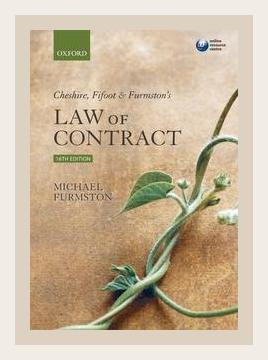Business Law and EthicsContract Law
**
Introduction:
“Cheshire, Fifoot, and Furmston’s Law of Contract” by M. P. Furmston is a comprehensive and authoritative text on contract law, widely used by students and practitioners alike. The 2017 edition continues to provide in-depth analysis and commentary on the principles and application of contract law in England and Wales. The book covers a broad range of topics including the formation of contracts, terms, performance, breach, remedies, and vitiating factors. This summary outlines key points from the book along with actionable advice supported by concrete examples.
1. Formation of Contracts
Understanding how contracts are formed is fundamental. The book covers essential elements such as offer, acceptance, consideration, and intention to create legal relations.
- Offer and Acceptance:
- Example: In Carlill v Carbolic Smoke Ball Co., a unilateral offer was made via advertisement.
-
Action: When making an offer, explicitly detail the terms to avoid ambiguity. Ensure that acceptance is clear and communicated.
-
Consideration:
- Example: The doctrine of consideration was exemplified in Currie v Misa, establishing a requirement of some value exchange in contracts.
-
Action: Ensure there is a clear exchange of value; whether goods, services, or another form of consideration, it must be identifiable.
-
Intention to Create Legal Relations:
- Example: Agreements among family members, as seen in Balfour v Balfour, generally lack intention to create legal relations.
- Action: For enforceable agreements, especially in informal contexts, explicitly state the legal intent.
2. Contractual Terms
Understanding the distinction between different types of terms helps in identifying the implications of breaches and interpreting agreements.
- Express and Implied Terms:
- Example: In Liverpool City Council v Irwin, the courts implied terms to give business efficacy.
-
Action: Clearly state all important terms in the contract. Where applicable, consider if terms need to be implied for the contract’s effective operation.
-
Conditions and Warranties:
- Example: The differentiation between conditions and warranties was crucial in Poussard v Spiers and Bettini v Gye.
- Action: Clarify if the term is a condition or warranty to understand the contractual remedies available in case of a breach.
3. Performance and Breach
The book delves into what constitutes proper performance and the implications of various types of breaches.
- Complete and Partial Performance:
- Example: The case of Cutter v Powell demonstrated the harshness of complete performance requirements under common law.
-
Action: Draft contracts with explicit provisions for partial performance where full performance may be impractical or impossible.
-
Breach of Contract:
- Example: Hong Kong Fir Shipping Co Ltd v Kawasaki Kisen Kaisha Ltd introduced the concept of “innominate terms”.
- Action: Assess whether the breach deprives the injured party of substantially the entire benefit. Consider drafting “innominate terms” carefully to address potential ambiguities.
4. Remedies for Breach
Remedies available for breach of contract are varied and the book offers detailed insights into them.
- Damages:
- Example: Hadley v Baxendale provides a foundational principle for understanding the remoteness of damages.
-
Action: Calculate potential damages considering the foreseeability test to manage risk effectively. Make clear any damages caps or exclusions in the contract.
-
Specific Performance and Injunctions:
- Example: Specific performance was discussed in Beswick v Beswick.
- Action: When seeking specific performance, ensure the subject matter is unique, and monetary compensation is insufficient.
5. Vitiating Factors
Factors that can undermine contracts are critical for understanding potential challenges to enforceability.
- Misrepresentation:
- Example: The difference between fraudulent, negligent, and innocent misrepresentation is illustrated by cases such as Derry v Peek and Hedley Byrne & Co Ltd v Heller & Partners Ltd.
-
Action: Ensure all statements made during negotiations are accurate and substantiated.
-
Mistake:
- Example: Smith v Hughes distinguishes between common and unilateral mistakes.
-
Action: Clarify assumptions explicitly to prevent misunderstandings and disputes arising from mistakes.
-
Duress and Undue Influence:
- Example: In Atlas Express Ltd v Kafco, economic duress was recognized.
- Action: Avoid any undue pressure tactics during contract formation to ensure enforceability.
6. Capacity to Contract
The capacity of parties entering a contract influences its validity.
- Minors:
- Example: Contracts with minors, as examined in Nash v Inman, are generally voidable.
-
Action: Verify the age and capacity of parties before entering into agreements.
-
Mental Incapacity:
- Example: The ruling in Imperial Loan Co Ltd v Stone emphasizes the need for a party to be able to understand the contract’s nature and effect.
- Action: Assess the mental capacity of the contracting parties to ensure valid formation.
7. Privity of Contract and Third Party Rights
The book discusses the rule of privity and notable exceptions.
- Doctrine of Privity:
- Example: Dunlop Pneumatic Tyre Co Ltd v Selfridge & Co Ltd reinforces the privity rule.
- Action: Incorporate third-party rights through express terms, considering the Contracts (Rights of Third Parties) Act 1999.
8. Termination of Contracts
Various mechanisms for contract termination are explored.
- Agreement and Discharge:
- Example: The implications of mutual discharge agreements as observed in Hochster v De La Tour.
- Action: Clearly outline terms for termination and mutual discharge mechanisms within the contract.
Conclusion:
“Cheshire, Fifoot, and Furmston’s Law of Contract” is an invaluable guide, rich with detailed case laws and practical applications. For anyone dealing in contract formation, performance, breach, and remedies, the actionable advice provided ensures robust contract management and legal compliance. This structured approach to contract law not only informs but empowers users to make informed decisions, mitigate risks, and handle disputes effectively.
